A tulku is a distinctive and significant aspect of Tibetan Buddhism, embodying the concept of enlightened beings taking corporeal forms to continue the lineage of specific teachings. The term "tulku" has its origins in the Tibetan word "sprul sku", which originally referred to an emperor or ruler taking human form on Earth, signifying a divine incarnation. Over time, this term evolved within Tibetan Buddhism to denote the corporeal existence of highly accomplished Buddhist masters whose purpose is to ensure the preservation and transmission of a particular lineage.

Ole Nydahl, also known as Lama Ole, is a lama providing Mahamudra teachings in the Karma Kagyu school of Tibetan Buddhism. Since the early 1970s, Nydahl has toured the world giving lectures and meditation courses. With his wife, Hannah Nydahl (1946-2007), he founded Diamond Way Buddhism, a worldwide Karma Kagyu Buddhist organization with over 600 centers for lay practitioners.
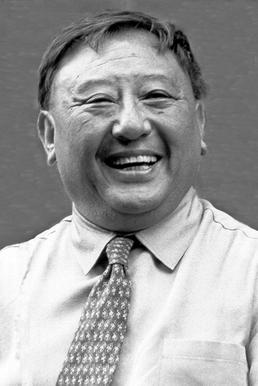
Kyabje Nawang Gehlek Rimpoche was a Tibetan Buddhist lama born in Lhasa, Tibet on October 26, 1939. His personal name was Gelek; kyabje and rimpoche are titles meaning "teacher" and "precious," respectively; he is known to Tibetans as Nyakre Khentrul Rinpoche. According to Thupten Jinpa, principal English translator to the Dalai Lama, he is considered
"an important link to the great lineages of Tibet’s great masters, especially of the Geluk school. Known more famously for the Tibetans as Nyakre Khentrul Rinpoche, Rinpoche had been instrumental in reprinting many of the Geluk texts in the 1970s, and also remained an important object of affection for both Kyabje Ling Rinpoche and Kyabje Trijang Rinpoche. Of course, his emergence as one of the great Tibetan teachers in the West has also been a source of inspiration for many.”

Tashi Paljor, Dilgo Khyentse Rinpoche was a Vajrayana master, scholar, poet, teacher, and recognized by Buddhists as one of the greatest realized masters. Head of the Nyingma school of Tibetan Buddhism from 1988 to 1991, he is also considered an eminent proponent of the Rime tradition.
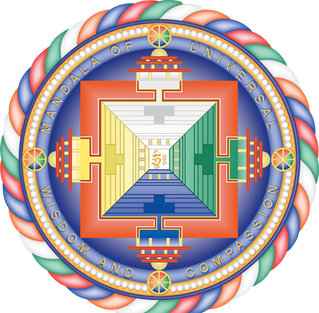
The Foundation for the Preservation of the Mahayana Tradition (FPMT) was founded in 1975 by Gelugpa Lamas Thubten Yeshe and Thubten Zopa Rinpoche, who began teaching Tibetan Buddhism to Western students in Nepal. The FPMT has grown to encompass over 138 dharma centers, projects, and services in 34 countries. Lama Yeshe led the organization until his death in 1984, followed by Lama Zopa until his death in 2023. The FPMT is now without a spiritual director; meetings on the organization's structure and future are planned.

Mindrolling Jetsün Khandro Rinpoche is a lama in Tibetan Buddhism. Born in Kalimpong, India and the daughter of the late Mindrolling Trichen, Khandro Rinpoche was recognized by Rangjung Rigpe Dorje, 16th Karmapa at the age of two as the reincarnation of the Great Dakini of Tsurphu Monastery, Urgyen Tsomo, who was one of the most well-known female masters of her time. Khandro Urgyen Tsomo was the consort to Khakyab Dorje, 15th Karmapa Lama (1871–1922) and recognised in this Buddhist tradition as an incarnation of Yeshe Tsogyal. Her name is in fact her title, Khandro being Tibetan for dakini and rinpoche an honorific usually reserved for tulkus that means "precious one."
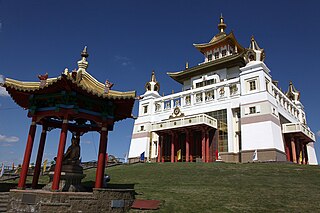
The Kalmyks are the only Mongolic-speaking people of Europe whose national religion is Buddhism. In 2016, 53.4% of the population surveyed identified themselves as Buddhist. They live in Kalmykia, a federal subject of Russia in the southwest. Kalmykia borders Dagestan to the south, Stavropol Krai to the southwest, Rostov Oblast to the west, Volgograd Oblast to the northwest, and Astrakhan Oblast to the east. The Caspian Sea borders Kalmykia to the southeast.
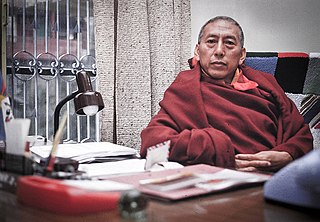
Lobsang Tenzin, better known by the titles Professor Venerable Samdhong Rinpoche and to Tibetans as the 5th Samdhong Rinpoche, is a Tibetan Buddhist monk and politician who served as the Prime Minister of the cabinet of the Central Tibetan Administration, the Tibetan government-in-exile based in Dharamshala, India.

Erdne-Basan Ombadykow, also known as Telo Tulku Rinpoche, is the Tibetan Buddhist spiritual leader of the Kalmyk people. He received his formal training as a bhikṣu in India and was recognized by the 14th Dalai Lama as the current reincarnation of mahasiddha Tilopa.
White Crane Films is an independent film production company founded in 1990 in London by filmmakers, Ritu Sarin and Tenzing Sonam. Focusing primarily on Tibet-related subjects, its productions include, The Reincarnation of Khensur Rinpoche (1991), The Trials of Telo Rinpoche (1993), A Stranger in My Native Land (1998), The Shadow Circus: The CIA in Tibet (1998), the Tibetan feature film, Dreaming Lhasa (2005), and The Thread of Karma (2007).
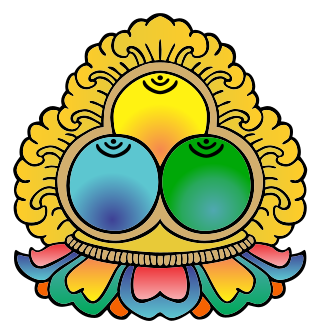
In Tibetan Buddhism, the Three Jewels and Three Roots are supports in which a Buddhist takes refuge by means of a prayer or recitation at the beginning of the day or of a practice session. The Three Jewels are the first and the Three Roots are the second set of three Tibetan Buddhist refuge formulations, the Outer, Inner and Secret forms of the Three Jewels. The 'Outer' form is the 'Triple Gem', the 'Inner' is the Three Roots and the 'Secret' form is the 'Three Bodies' or trikāya of a Buddha.

Lobsang Tubten Jigme Gyatso (bot=བློ་བཟང་ཐུབ་བསྟན་འཇིགས་མེད་རྒྱ་མཚོ་), officially the 8th Arjia Hotogtu(bot=ཨ་ཀྱཱ་ཧོ་ཐོག་ཐུ།), born 1950 in Haiyan County, Qinghai) is one of the most prominent Buddhist teachers and lamas to have left Tibet. At age two, Arjia Rinpoche was recognized by Choekyi Gyaltsen, 10th Panchen Lama as the 20th Arjia Danpei Gyaltsen, the reincarnation of Je Tsongkhapa's father, Lumbum Ghe, the throne holder and abbot of Kumbum Monastery. He has trained with lineage teachers, such as the 14th Dalai Lama, the 10th Panchen Lama, and Gyayak Rinpoche—from whom he received many sacred teachings and ritual instructions.
Khunu Lama Tenzin Gyaltsen, 1894–1977, known also as Negi Lama Tenzin Gyaltsen, Tenzin Gyaltsen, and various other names like Kunu Rinpoche, Kunu Lama and Negi Lama, was born in 1894 in the village of Sunam which lies in the Kinnaur district of India in the western Himalayas. He passed away at the age of 82 at Shashur Monastery in the Lahaul and Spiti district of Himachel Pradesh on February 23, 1977, while teaching the final page of Gampopa's Jewel Ornament of Liberation. Khunu Rinpoche was not officially recognized as a tulku, nor was he an ordained Buddhist monk, but a layman who had taken lay practitioner's vows before becoming a Tibetan Buddhist master.
Thekchen Choling is a registered Buddhist organisation in the Republic of Singapore. The organisation was started in 2001 by Singha Thekchen Rinpoche and a group of his initial disciples. The organisation promotes non-sectarian Buddhism, emphasizing understanding of Theravada and Mahayana teachings. TCCL is committed to the Rime (non-sectarian) movement within Tibetan Buddhism though it is of the Gelug tradition. The primary practices and teachings of this temple are from Guru Rinpoche lineage and Lama Tsongkapa lineage.

Dezhung Rinpoche Kunga Tenpai Nyima, born Kunchok Lhundrup, was a Tibetan lama of the Sakya school. Sakya is one of four major schools of Tibetan Buddhism, the others being the Nyingma, Kagyu, and Gelug. In 1960 he came to Seattle, Washington in the United States of America, one of the first Tibetan lamas to settle and teach in the United States.

Dagpo Rinpoche, also known as Bamchoe Rinpoche, is a lama in the Tibetan Buddhist tradition.
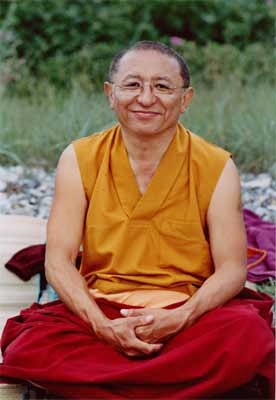
Chökyi Nyima Rinpoche is a Tibetan Buddhist teacher and meditation master. He is the abbot of Ka-Nying Shedrub Ling Monastery in Kathmandu, Nepal. He is the author of several books, founder of meditation centers around the world, and an international teacher.
The incumbent 14th Dalai Lama once suggested the different possibilities of reincarnation for the next (15th) Dalai Lama, but because of the feudal origin of the Dalai Lama reincarnation system, he suggested the reincarnation system should end. The selection process remains controversial, as the atheist Chinese government has declared ownership on the selection process using the Golden Urn for the next Dalai Lama.
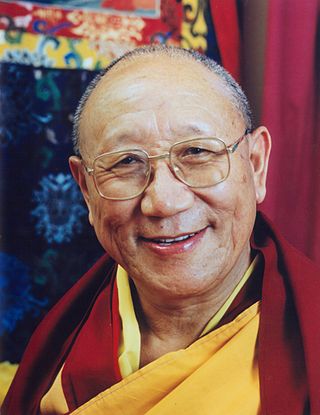
Kyabje Khensur Kangurwa Lobsang Thubten Rinpoche, was a Buddhist monk, Abbot of Sera Jey Monastery, and the founder of Tibetan Buddhist Institute (Adelaide). Khensur means "former abbot" and Rinpoche means "precious teacher."

Lama Jigme Rinpoche is an author and teacher in the Karma Kagyu school of Tibetan Buddhism. Born into the family of Rangjung Rigpe Dorje, 16th Karmapa, he is the brother of the late 14th Shamar Rinpoche, Mipham Chokyi Lodro. The 16th Karmapa appointed Lama Jigme Rinpoche as his European representative. He asked him to oversee the development of a shedra (university), library, retreat center, and monastery at Dhagpo Kagyu Ling in Dordogne, France, where Jigme Rinpoche is currently the main representative of Trinley Thaye Dorje and head of the monastery.















